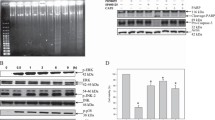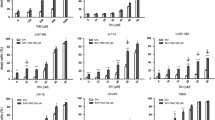Abstract
The isolation of new molecules from marine sources opens the door to their possible therapeutic use against tumors and other pathological conditions. Indeed, we recently defined the cytotoxicity of ES 285, obtained from the clam Mactromeris polynima, and its affects on the cells microfilament but not the microtubule network. Considering the analogy between ES 285 and sphingosine-related lipids, we wondered whether ES 285 might affect the activity of PKC at the intracellular level. While we anticipated that ES 285 might inhibit PKC, it turns out that in contrast it serves to activate PKC at the cellular level. Indeed, like other sphingosine-related lipids, ES 285 induces the phosphorylation of MARCKS. Additionally, we further examined the cytotoxicity of ES 285 to elucidate the molecular mechanisms through which this compound triggers apoptosis. When the influence of ES 285 on “cell death markers” was assessed, it became clear that ES285 activates caspase 3 and 12, and that it modified the phosphorylation of p53. In contrast, ES 285 does not affect other pathways widely implicated in regulating cell survival/apoptosis, such as JNK, Erks or Akt. Thus, these data suggest that ES 285-triggers an atypical cell death program when compared to other sphingosine-dependent apoptosis pathways.
Similar content being viewed by others
References
Aune GJ, Furuta T, Pommier Y (2002) Ecteinascidin 743: a novel anticancer drug with a unique mechanism of action. Anticancer Drugs 13:545–555
Cuadros R, Montejo de Garcini E, Wandosell F, Faircloth G, Fernandez-Sousa JM, Avila J (2000) The marine compound spisulosine, an inhibitor of cell proliferation, promotes the disassembly of actin stress fibers. Cancer Lett 152:23–29
Spiegel S, Kolesnick R (2002) Sphingosine 1-phosphate as a therapeutic agent. Leukemia 16:1596–1602
Brindley DN, English D, Pilquil C, Buri K, Ling ZC (2002) Lipid phosphate phosphatases regulate signal transduction through glycerolipids and sphingolipids. Biochim Biophys Acta 1582:33–44
Moolenaar WH (1999) Bioactive lysophospholipids and their G protein-coupled receptors. Exp Cell Res 253:230–238
Lynch KR, Macdonald TL (2002) Structure-activity relationships of lysophosphatidic acid analogs. Biochim Biophys Acta 1582:289–294
Payne SG, Milstien S, Spiegel S (2002) Sphingosine-1-phosphate: dual messenger functions. FEBS Lett 531:54–57
van Corven EJ, Groenink A, Jalink K, Eichholtz T, Moolenaar WH (1989) Lysophosphatidate-induced cell proliferation: identification and dissection of signaling pathways mediated by G proteins. Cell 59:45–54
Hooks SB, Santos WL, Im DS, Heise CE, Macdonald TL, Lynch KR (2001) Lysophosphatidic acid-induced mitogenesis is regulated by lipid phosphate phosphatases and is Edg-receptor independent. J Biol Chem 276:4611–4621
Weiner JA, Chun J (1999) Schwann cell survival mediated by the signaling phospholipid lysophosphatidic acid. Proc Natl Acad Sci USA 96:5233–5238
Hisano N, Yatomi Y, Satoh K et al (1999) Induction and suppression of endothelial cell apoptosis by sphingolipids: a possible in vitro model for cell-cell interactions between platelets and endothelial cells. Blood 93:4293–4299
Tigyi G, Fischer DJ, Sebok A, Marshall F, Dyer DL, Miledi R (1996) Lysophosphatidic acid-induced neurite retraction in PC12 cells: neurite- protective effects of cyclic AMP signaling. J Neurochem 66:549–558
Fukushima N, Weiner JA, Kaushal D et al (2002) Lysophosphatidic acid influences the morphology and motility of young, postmitotic cortical neurons. Mol Cell Neurosci 20:271–282
Kranenburg O, Poland M, Gebbink M, Oomen L, Moolenaar WH (1997) Dissociation of LPA-induced cytoskeletal contraction from stress fiber formation by differential localization of RhoA. J Cell Sci 110:2417–2427
Zhang Q, Peyruchaud O, French KJ, Magnusson MK, Mosher DF (1999) Sphingosine 1-phosphate stimulates fibronectin matrix assembly through a Rho-dependent signal pathway. Blood 93:2984–2990
Postma FR, Jalink K, Hengeveld T et al (1996) Serum-induced membrane depolarization in quiescent fibroblasts: activation of a chloride conductance through the G protein-coupled LPA receptor. Embo J 15:63–72
Sakakura C, Sweeney EA, Shirahama T et al (1998) Selectivity of sphingosine-induced apoptosis. Lack of activity of DL-erythyro-dihydrosphingosine. Biochem Biophys Res Commun 246:827–830
Hofmann J (2001) Modulation of protein kinase C in antitumor treatment. Rev Physiol Biochem Pharmacol 142:1–96
Caponigro F, French RC, Kaye SB (1997) Protein kinase C: a worthwhile target for anticancer drugs? Anticancer Drugs 8:26–33
Schwartz GK, Jiang J, Kelsen D, Albino AP (1993) Protein kinase C: a novel target for inhibiting gastric cancer cell invasion. J Natl Cancer Inst 85:402–407
Marks F, Gschwendt M (1995) Protein kinase C and skin tumor promotion. Mutat Res 333:161–172
Ohno S, Nishizuka Y (2002) Protein kinase C isotypes and their specific functions: prologue. J Biochem (Tokyo) 132:509–511
Saito N, Shirai Y (2002) Protein kinase C gamma (PKC gamma): function of neuron specific isotype. J Biochem (Tokyo) 132:683–687
Nakashima S (2002) Protein kinase C alpha (PKC alpha): regulation and biological function. J Biochem (Tokyo) 132:669–675
da Rocha AB, Mans DR, Regner A, Schwartsmann G (2002) Targeting protein kinase C: new therapeutic opportunities against high-grade malignant gliomas? Oncologist 7:17–33
Brose N, Rosenmund C (2002) Move over protein kinase C, you’ve got company: alternative cellular effectors of diacylglycerol and phorbol esters. J Cell Sci 115:4399–4411
Fishman DD, Segal S, Livneh E (1998) The role of protein kinase C in G1 and G2/M phases of the cell cycle (review). Int J Oncol 12:181–186
Brodie C, Blumberg PM (2003) Regulation of cell apoptosis by protein kinase c delta. Apoptosis 8:19–27
Ganong BR, Loomis CR, Hannun YA, Bell RM (1986) Specificity and mechanism of protein kinase C activation by sn-1,2-diacylglycerols. Proc Natl Acad Sci USA 83:1184–1188
Kanoh H, Yamada K, Sakane F (2002) Diacylglycerol kinases: emerging downstream regulators in cell signaling systems. J Biochem (Tokyo) 131:629–633
Ron D, Kazanietz MG (1999) New insights into the regulation of protein kinase C and novel phorbol ester receptors. Faseb J 13:1658–1676
Ohmori S, Sakai N, Shirai Y et al (2000) Importance of protein kinase C targeting for the phosphorylation of its substrate, myristoylated alanine-rich C-kinase substrate. J Biol Chem 275:26449–26457
Hannun YA, Bell RM (1986) Phorbol ester binding and activation of protein kinase C on triton X-100 mixed micelles containing phosphatidylserine. J Biol Chem 261:9341–9347
Helfman DM, Barnes KC, Kinkade JM, Jr, Vogler WR, Shoji M, Kuo JF (1983) Phospholipid-sensitive Ca2+-dependent protein phosphorylation system in various types of leukemic cells from human patients and in human leukemic cell lines HL60 and K562, and its inhibition by alkyl-lysophospholipid. Cancer Res 43:2955–2961
Shoji M, Vogler WR, Kuo JF (1985) Inhibition of phospholipid/Ca2+-dependent protein kinase and phosphorylation of leukemic cell proteins by CP-46,665-1, a novel antineoplastic lipoidal amine. Biochem Biophys Res Commun 127:590–595
Hannun YA, Loomis CR, Merrill AH, Jr, Bell RM (1986) Sphingosine inhibition of protein kinase C activity and of phorbol dibutyrate binding in vitro and in human platelets. J Biol Chem 261:12604–12609
Sachs CW, Safa AR, Harrison SD, Fine RL (1995) Partial inhibition of multidrug resistance by safingol is independent of modulation of P-glycoprotein substrate activities and correlated with inhibition of protein kinase C. J Biol Chem 270:26639–26648
Bit RA, Davis PD, Elliott LH et al (1993) Inhibitors of protein kinase C. 3. Potent and highly selective bisindolylmaleimides by conformational restriction. J Med Chem 36:21–29
Toullec D, Pianetti P, Coste H et al (1991) The bisindolylmaleimide GF 109203X is a potent and selective inhibitor of protein kinase C. J Biol Chem 266:15771–15781
Spiegel S, Kolesnick R (2002) Sphingosine 1-phosphate as a therapeutic agent. Leukemia 16:1596–1602
Brindley DN, English D, Pilquil C, Buri K, Ling ZC (2002) Lipid phosphate phosphatases regulate signal transduction through glycerolipids and sphingolipids. Biochim Biophys Acta 1582:33–44
Tigyi G (2001) Selective ligands for lysophosphatidic acid receptor subtypes: gaining control over the endothelial differentiation gene family. Mol Pharmacol 60:1161–1164
Zhao Y, Neltner BS, Davis HW (2000) Role of MARCKS in regulating endothelial cell proliferation. Am J Physiol Cell Physiol 279:C1611–1620
Aderem A (1992) The MARCKS brothers: a family of protein kinase C substrates. Cell 71:713–716
Blackshear PJ (1993) The MARCKS family of cellular protein kinase C substrates. J Biol Chem 268:1501–1504
Agopyan N, Agopyan I (1991) Effects of protein kinase C activators and inhibitors on membrane properties, synaptic responses, and cholinergic actions in CA1 subfield of rat hippocampus in situ and in vitro. Synapse 7:193–206
Goetzl EJ (2001) Pleiotypic mechanisms of cellular responses to biologically active lysophospholipids. Prostaglandins 64:11–20
Fukushima N, Chun J (2001) The LPA receptors. Prostaglandins 64:21–32
Kazanietz MG (2002) Novel “nonkinase” phorbol ester receptors: the C1 domain connection. Mol Pharmacol 61:759–767
Blatt NB, Glick GD (2001) Signaling pathways and effector mechanisms pre-programmed cell death. Bioorg Med Chem 9:1371–1384
Herr I, Debatin KM (2001) Cellular stress response and apoptosis in cancer therapy. Blood 98:2603–2614
Datta SR, Dudek H, Tao X et al (1997) Akt phosphorylation of BAD couples survival signals to the cell-intrinsic death machinery. Cell 91:231–241
Dudek H, Datta SR, Franke TF et al (1997) Regulation of neuronal survival by the serine-threonine protein kinase Akt. Science 275:661–665
Haupt S, Berger M, Goldberg Z, Haupt Y (2003) Apoptosis–-the p53 network. J Cell Sci 116:4077–4085
Earnshaw WC, Martins LM, Kaufmann SH (1999) Mammalian caspases: structure, activation, substrates, and functions during apoptosis. Annu Rev Biochem 68:383–424
Cuadros R, Montejo de Garcini E, Wandosell F, Faircloth G, Fernandez-Sousa JM, Avila J (2000) The marine compound spisulosine, an inhibitor of cell proliferation, promotes the disassembly of actin stress fibers. Cancer Lett 152:23–29
Wilson E, Rice WG, Kinkade JM, Jr., Merrill AH, Jr., Arnold RR, Lambeth JD (1987) Protein kinase C inhibition by sphingoid long-chain bases: effects on secretion in human neutrophils. Arch Biochem Biophys 259:204–214
Rao RV, Ellerby HM, Bredesen DE (2004) Coupling endoplasmic reticulum stress to the cell death program. Cell Death Differ 11:372–380
Szegezdi E, Fitzgerald U, Samali A (2003) Caspase-12 and ER-stress-mediated apoptosis: the story so far. Ann NY Acad Sci 1010:186–194
Hitomi J, Katayama T, Taniguchi M, Honda A, Imaizumi K, Tohyama M (2004) Apoptosis induced by endoplasmic reticulum stress depends on activation of caspase-3 via caspase-12. Neurosci Lett 357:127–130
Park MT, Kang JA, Choi JA et al (2003) Phytosphingosine induces apoptotic cell death via caspase 8 activation and Bax translocation in human cancer cells. Clin Cancer Res 9:878–885
Suzuki E, Handa K, Toledo MS, Hakomori S (2004) Sphingosine-dependent apoptosis: a unified concept based on multiple mechanisms operating in concert. Proc Natl Acad Sci USA 101:14788–14793
Author information
Authors and Affiliations
Corresponding author
Rights and permissions
About this article
Cite this article
Salcedo, M., Cuevas, C., Alonso, J.L. et al. The marine sphingolipid-derived compound ES 285 triggers an atypical cell death pathway. Apoptosis 12, 395–409 (2007). https://doi.org/10.1007/s10495-006-0573-z
Published:
Issue Date:
DOI: https://doi.org/10.1007/s10495-006-0573-z




